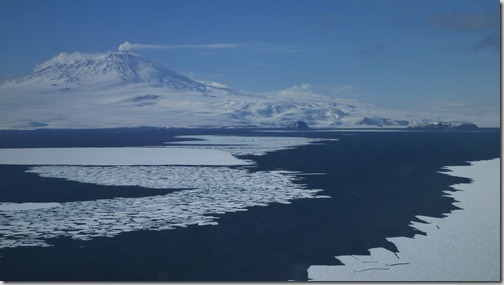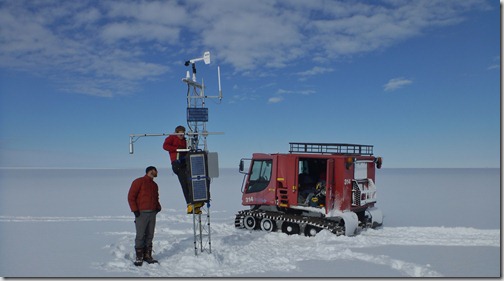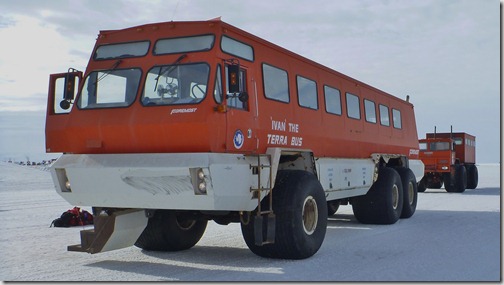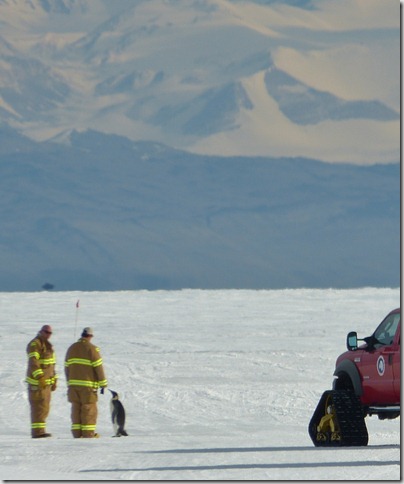For the first time during my 6 week stay in McMurdo, the phone in our dorm room rang to life. Awaking from a deep, restive sleep after our Ross Ice Shelf adventure, I noted that the time on the digital clock read 9:00am. In my groggy state, I overheard a conversation with none other than Natalie from helo ops. A minute later, we learned that we had been scheduled for a 9:15am flight to Marble Point, but we were certainly too late. Instead, we postponed the quick trip to 2:30pm and set about our work.
 Five minutes before the scheduled departure time, Lars and I found ourselves strapped into an A-Star helicopter and rising above McMurdo. Compared to the larger, utilitarian Bell 212s, the A-Star felt like a sports car with comfortable seating and remarkable panoramic views of the landscape sweeping by below us. Although we had completed the four installations already, data from the Marble Point site was out of sorts and a mission was scheduled to quickly retrieve the instrument so Lars could troubleshoot it back in the warmth of the Crary Lab. With only 2 days remaining in my Antarctic stay, this quick jaunt would be my final time in the air over the Ross Island region, and the large windows provided an ideal vantage point to soak in the landscape. In the time since our first installation at Marble Point, the Ross Sea ice had retreated significantly and our flight path was compensated to keep us safely over ice in case of an emergency touch down. Although now familiar, the sights of Mount Erebus, Ross Island, Dry Valleys, and Transantarctic mountains were as appealing as the first time I laid eyes on them. The landing next to the ozone station was without incident and as we retrieved the instrument from the Hardigg case, the pilot hopped 2 miles up the coast to drop some food and top off fuel at the small Marble Point field camp. Our work was completed in short order and when the chopper returned, I was offered the front seat next to the pilot which I gladly accepted. The return flight to McMurdo provided stupendous views and I savored each moment of my last helicopter flight over Antarctica. Within 2 hours of leaving, we were back in the lab with the instrument disassembled and diagnosed with a faulty pump that would easily be replaced before its eventual return to the wild by Sam and Lars.
Five minutes before the scheduled departure time, Lars and I found ourselves strapped into an A-Star helicopter and rising above McMurdo. Compared to the larger, utilitarian Bell 212s, the A-Star felt like a sports car with comfortable seating and remarkable panoramic views of the landscape sweeping by below us. Although we had completed the four installations already, data from the Marble Point site was out of sorts and a mission was scheduled to quickly retrieve the instrument so Lars could troubleshoot it back in the warmth of the Crary Lab. With only 2 days remaining in my Antarctic stay, this quick jaunt would be my final time in the air over the Ross Island region, and the large windows provided an ideal vantage point to soak in the landscape. In the time since our first installation at Marble Point, the Ross Sea ice had retreated significantly and our flight path was compensated to keep us safely over ice in case of an emergency touch down. Although now familiar, the sights of Mount Erebus, Ross Island, Dry Valleys, and Transantarctic mountains were as appealing as the first time I laid eyes on them. The landing next to the ozone station was without incident and as we retrieved the instrument from the Hardigg case, the pilot hopped 2 miles up the coast to drop some food and top off fuel at the small Marble Point field camp. Our work was completed in short order and when the chopper returned, I was offered the front seat next to the pilot which I gladly accepted. The return flight to McMurdo provided stupendous views and I savored each moment of my last helicopter flight over Antarctica. Within 2 hours of leaving, we were back in the lab with the instrument disassembled and diagnosed with a faulty pump that would easily be replaced before its eventual return to the wild by Sam and Lars.
 Even though we had finished the deployments of the primary ozone stations and our time on the ice was quickly dwindling, the test unit was still living in the lab after its retrieval from Windless Bight. So with my departure quickly approaching the following day, we loaded into a Pisten Bully for a third and final trip to Windless Bight. The tracked vehicle moved slowly through town and onto the flagged ice route that we had traversed twice before, but after 1.5 hours, we reached our previous farthest point and faced fresh powder in the direction of the AWS where the ozone station would reside. Sitting behind the wheel of this snow machine, I pointed at a spec in the distance, held the throttle open, and floated 2 miles over the fluffy snow which churned out clouds of white behind us. Unlike the primary ozone stations, the test unit used a much smaller, preconfigured power system and only needed to fastened to the north side of the existing AWS tower. Half an hour later, the work was completed and we slowly, uneventfully wound our way back to McMurdo.
Even though we had finished the deployments of the primary ozone stations and our time on the ice was quickly dwindling, the test unit was still living in the lab after its retrieval from Windless Bight. So with my departure quickly approaching the following day, we loaded into a Pisten Bully for a third and final trip to Windless Bight. The tracked vehicle moved slowly through town and onto the flagged ice route that we had traversed twice before, but after 1.5 hours, we reached our previous farthest point and faced fresh powder in the direction of the AWS where the ozone station would reside. Sitting behind the wheel of this snow machine, I pointed at a spec in the distance, held the throttle open, and floated 2 miles over the fluffy snow which churned out clouds of white behind us. Unlike the primary ozone stations, the test unit used a much smaller, preconfigured power system and only needed to fastened to the north side of the existing AWS tower. Half an hour later, the work was completed and we slowly, uneventfully wound our way back to McMurdo.
Much as during my first days in McMurdo, the last ones were filled with little down time. So after dropping my bags off to be palletized for the next day’s flight, it was time to celebrate. A group of old and new friends gathered for wine at the Coffee House after which an impromptu party ensued in our dorm’s lounge. It was a fine way to spend my last night in Antarctica, but with knowledge of a full day ahead, the party had to an end and I turned in for my last night in the dreaded top bunk.
My to-do list was rapidly reaching completion as the hour of my departure drew near, but there was one final challenge I had yet to attempt. Throughout my time in McMurdo, I made a concerted effort to maintain my gym and running schedules and along the way came to really enjoy the two arduous loops around Hut Point and Ob Hill. At some point, I decided that if each loop was good on its own, combining them into a great figure “8” would be the best way to tour the town and get a great work out. With plenty of warm gear to combat the cold winds of the exposed ridgelines, I set out on my run with an ascent of Hut Point Ridge first. Upon reaching the historic cross at the point, another fellow and I spotted two Menke whales spouting in the water near the ice. Once again, I had been graced with a beautiful display of nature and knew that my experience was very near complete. Despite being twice my previous running distance, the loop progressed wonderfully and I savored the McMurdo views for the last time.
 Having thoroughly enjoyed monster truck races in my youth, one of my favorite scenes in Encounters at the End of the World involved the largest bus in the world, Ivan the Terra Bus. Sitting on massive balloon tires that allow it to traverse the sea ice, the bus is a complete monstrosity that happily exists among the varied vehicular oddities of Antarctica. When I arrived in Antarctica, I was disappointed to learn that I would not ride on Ivan, but for my departure, I was treated with a ride on the huge bus out to the Pegasus runway. Shortly after arriving at the haphazard airfield, the sea of Big Red jackets focused their sights on a drama that was playing itself out a few hundred yards away near the runway. Dressed in bright yellow gear, two firefighters stood toe-to-toe with a nemesis they had never been trained to face. Standing half their height, but with great pride as the king of the Antarctic continent, an Emperor penguin begrudgingly moved off the airstrip in response to their repeated shooing motions. And then with the comedy of a silent film, the penguin would turn about, face the fire fighters like Joe Piscapo and refuse to move another step. Although, the distance between the peanut gallery and the comedic act was large, we were all certain that the penguin was shaking his head in defiance and saying, “Are you talkin’ to me?”
Having thoroughly enjoyed monster truck races in my youth, one of my favorite scenes in Encounters at the End of the World involved the largest bus in the world, Ivan the Terra Bus. Sitting on massive balloon tires that allow it to traverse the sea ice, the bus is a complete monstrosity that happily exists among the varied vehicular oddities of Antarctica. When I arrived in Antarctica, I was disappointed to learn that I would not ride on Ivan, but for my departure, I was treated with a ride on the huge bus out to the Pegasus runway. Shortly after arriving at the haphazard airfield, the sea of Big Red jackets focused their sights on a drama that was playing itself out a few hundred yards away near the runway. Dressed in bright yellow gear, two firefighters stood toe-to-toe with a nemesis they had never been trained to face. Standing half their height, but with great pride as the king of the Antarctic continent, an Emperor penguin begrudgingly moved off the airstrip in response to their repeated shooing motions. And then with the comedy of a silent film, the penguin would turn about, face the fire fighters like Joe Piscapo and refuse to move another step. Although, the distance between the peanut gallery and the comedic act was large, we were all certain that the penguin was shaking his head in defiance and saying, “Are you talkin’ to me?”
 This final scene of Antarctica filled my head along with the countless other of the previous 6 weeks as I boarded the voluminous C-17 military transport jet. My time on the continent was filled with adventure, beauty, wonder, learning, and of course, work. Under the guidance and leadership of Lars, we had successfully completed our campaign to install the network of ground ozone stations, so with a sense of accomplishment, I proudly left the white continent of Antarctica.
This final scene of Antarctica filled my head along with the countless other of the previous 6 weeks as I boarded the voluminous C-17 military transport jet. My time on the continent was filled with adventure, beauty, wonder, learning, and of course, work. Under the guidance and leadership of Lars, we had successfully completed our campaign to install the network of ground ozone stations, so with a sense of accomplishment, I proudly left the white continent of Antarctica.
Although the C-17 was quieter and faster than the LC-130 that we took from Christchurch to McMurdo, the 5 hour return flight was still noisy and rough. After touch down on the tarmac, we all experienced something for the first time in months– darkness. Looking high in the sky over our aircraft, the full moon graced the sky and it was clear that we had been transported to a new place.
After coordinating with several McMurdo acquaintances, I joined forces with two friends I met during my first week in town. Alia, James, and I piled our gear and ourselves into the little Nissan rental car and headed north to the coastal town of Kaikoura for a few days of R&R before they continued their journeys back to the states. Following dinner in town, we made our way to the rocky beach to enjoy a few beers in the welcome darkness. One Speights flowed into another as we shared our respective takes on Antarctic life, and the cathartic experience felt truly complete when we realized that we had been standing in a gentle rain for over an hour. Antarctica had been washed into the past, and a New Zealand adventure awaited me.
